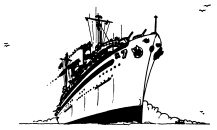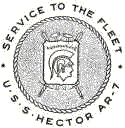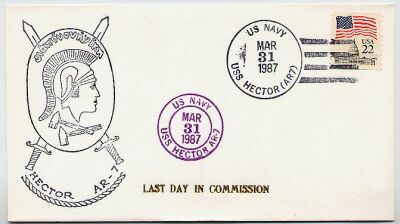 |
USS Hector AR-7
|
 |
 |
USS Hector AR-7
|
 |
As everyone knows all historical documents are subject to omissions and errors. As information comes to
our attention we will make the necessary corrections. If you have documentation of any corrections that
need to be included in history please send it to us. We will include anything of historical value as long
as it can be validated. It is our intention that everything here will be as accurate as possible.
We believe we have the most complete History of the USS Hector available - anywhere.
FOR MORE IN-DEPTH DETAILS OF HECTOR'S INVOLVEMENT IN WWII,
PLEASE VISIT: USS HECTOR'S WAR CRUISEIn Homer's Illiad, HECTOR, one of Pream's fifty sons, was defender of Troy and bravest of all Trojans. He slew Patrocles and in turn was slain by Achilles.
MOTTO (in Greek): through work, the victory
DISP LENGTH BEAM DRAFT SPEED CREW ARMAMENT 9140
16200529' 6" 73' 6" 23' 4" 19 knots 1000+ 4 5"38
8 40mm
8 20MMHECTOR was the third in a series of four VULCAN class Repair Ships, and was built by the Los Angeles Shipbuilding and Drydock Corporation in San Pedro, California. She was christened by Mrs. Ramona Heim, wife of Captain Schuyler Heim USN, and launched 11 November 1942. HECTOR was commissioned 7 February 1944. (NOTE: To set the record straight, some websites claim that HECTOR was a modified Liberty Ship, but this would be impossible due to the fact that Liberty Ships were 441' in length with a 56' beam)
After shakedown along the West Coast, she sailed the Pacific, arriving in Pearl Harbor on 9 April 1944. She departed for Eniwetok on 5 June, arriving there 13 June. HECTOR spent the summer there, and on 30 September, departed for Ulithi. Her largest repair job in WWII was the USS HOUSTON which was torpedoed twice by Japanese submarines. The HOUSTON was towed alongside on 27 October. Although hampered by a severe typhoon season, which twice sent her out to sea for safety, HECTOR managed to repair HOUSTON by the end of 1944; this in addition to repairs on other ships.
HECTOR departed Ulithi 16 February 1945 and arrived at Tarragona, Leyte Gulf, to repair ships during the battle for the Philippines. She then returned to Ulithi 30 March and on to Saipan 22 May.
After WWII in the Pacific ended, Hector remained in the Pacific and Asiatic areas during the occupation duties, earning the China Service Medal for the period 27 May-24 Oct 1947, and prepared various ships for return to CONUS.
HECTOR departed Saipan and arrived at Long Beach in early February 1946. After a year of doing repair work in Long Beach, she got underway in May 1947 for her first peacetime West-Pac tour. She spent May 7th - 12th in Pearl Harbor before departing for Tsingtao, China. After spending May 26th - October 14th there, she departed for Shanghai, China arriving on the 15th. She departed Shanghai just three day later for Hong Kong, and then after two days she headed for Guam. Hector arrived in Guam where she did fleet repairs until departing for Eniwetok on the 6th of January 1948 where she took part in "Operation Sandstone", after which she headed for CONUS via Pearl Harbor, arriving at Pearl on the 21st of March. After spending 3 days in Pearl she headed for Bremerton, Washington, via Bangor, to off load ammunition, for a much needed yard period.
On the 12th of June Hector departed the Puget Sound Naval Shipyard and headed for San Diego, California where she did fleet repairs until departing for Long Beach on the 19th of August, and arriving there the same day. Hector's stay in Long Beach from 19th August 1948 until April 26, 1950 was interrupted only one time when she participated in OPERATION MIKI in Hawaii, from the 17th of October until the 7th of November, 1949.
Shortly after the Korean War began, HECTOR sailed into Yokosuka, Japan, on 18 September 1950, then to Inchon, Korea, for the amphibious assault on 25 September. After participating in the Inchon Invasion, Hector took station in Sasebo harbor, Bouy 16 repairing over 200 various ships damaged during the Korean War and serving as flag ship for Service Squadron 3. Hector returned to her home port of Long Beach on Saturday November 17, 1951 ending a fourteen month deployment in Far Eastern waters. For the period 17 Sept 1950 - 4 Oct 1951, Hector earned the Korean Service Medal with one Star for North Korean Aggression during 23 Sept 1950 - 4 Oct 1950. For the remainder of the Korean War, HECTOR alternated repair service along the Korean Coast, in Japan, and normal duty out of Long Beach. In 1954 she was presented with the Battle Efficiency Plaque for the year 1953-1954, and again in 1955 was awarded the the same plaque for the year 1954-1955.
During the second half of the 1950ís, HECTOR alternated 4-6 months of service and exercises along the California Coast with 6-8 month West-Pac tours. During these cruises, HECTOR, operating in support of the nations far-flung Pacific and Asian defenses, visited the ports of Yokosuka, Sasebo, Kobe, Hong Kong, Shanghai, Kaoshiung, Guam and Eniwetok, serving intermittently as flagship for Service Squadrons 1 and 3. HECTOR was also a major participant in the U.S. Navy's "People to People" program in Asia. Her deployments to the Western Pacific continued into the 1960s.
From 1 Feb 1962 through 28 may 1962 Hector was out of service for regular overhaul and drydocking at Bethlehem Steel Corporation, Terminal Island, California, and for post-repair trails. In June, underway training exercise were held. On 29 Nov 1962, Captain Robert Lander relieved Captain Ovid Butler as Commander Service Squadron One, with change of command ceremonies held aboard Hector.
From June 1963 to January 1964, HECTOR made visits to Agashima, Sasebo, Yokosuka, Iwakuni, Keelung and Subic Bay. The crew had their R&R in Manila and Nagasaki. During this deployment, Hector was again the Flagship for Commander Service Squadron Three. In late 1964, the TV Series "CONVOY" starring Gia Scala, John Gavin and John Larch was filmed aboard Hector. The pilot episode, "Night Rendezvous", featured a simulated torpedo hit with smoke, fire, gashes in bulkhead, and rescue at sea.
In early 1965, at Alameda, California, HECTOR set a record by tending 28 ships at one time, 13 of which were alongside.
Between July 1965 and February 1966, she underwent a modernization overhaul at Long Beach. She resumed fleet services out of Long Beach until departing for another West-Pac cruise on 5 August 1966. During the next 6 months she serviced and repaired ships in the Philippines, Taiwan, and Japan, returning to CONUS in mid-1967. She then continued with stateside repairs to the fleet and West-Pac cruises.
During the late 60's, Hector's WESTPAC cruises brought her to Pearl Harbor; Subic Bay, R.P.; Kaohsuing, Taiwan; as well as Sasebo & Yokosuka, Japan where she provided her repair services to the Seventh Fleet. Her crew had their well-deserved R&R in the port of Hong Kong.
From February to March 1969, Hector took over all in-port ship repairs in Pearl Harbor to allow the entire shore maintenance crews to work on the USS Enterprise, which had sustained damage to her flight deck from a landing plane. While enroute to to Okinawa in June 1969, Hector's boilers broke down, and returned to Subic Bay for repairs which were made by the crew. In late August, Hector steamed slowly Stateside where she finally entered Todd Shipyards in San Pedro, CA (her birthplace) on 17 Nov 1969. There began an extensive "yard period" where most aspects of the engineering plant received a major overhauling, the two large cranes were completely redone, an entire new communications center was installed, repairs performed on the hull, and much of the exterior of the ship was sandblasted & re-painted. On 20 March 1970, Hector successfully completed a day of sea trials.
On June 23, 1970 Hector departed Long Beach and arrived in Sasebo, Japan on the 10th of July. After a 10-day layover she departed for Vung Tau, Vietnam where she provided services to the fleet until her departure on 16 August, for which she received her first Vietnam Service Medal. After a four-day visit to Hong Kong she headed for Sasebo where she provided services to the fleet from 27 August until 11 January . After a short trip to Keelung, Taiwan she left Sasebo on 30 January for the USA and arrived in Long Beach on 15 February 1971.
Hector provided service to the fleet for the rest of 1971 in Long Beach. Once again Hector departed for WESTPAC via Pearl Harbor on January 3, 1972 arriving in Sasebo January 26th where she served as the flagship for COMSERVGRU THREE. While providing service to the fleet during this deployment Hector visited Vung Tau, Vietnam, Hong Kong, DaNang, Vietnam, Subic Bay RP, Okinawa, and Keelung, Taiwan. On Aug 26 Hector was relieved as COMSERVGRU THREE Flagship and departed Sasebo for the USA and arrived in Long Beach on September 9, 1972.
In 1972 Hector was awarded a MERITORIOUS UNIT COMMENDATION that read in part the following: For meritorious service from 26 January to 25 August 1972 in direct support of United States SEVENTH Fleet combat operations in Southeast Asia. USS HECTOR contributed materially to the success of these operations by rendering vital fleet repair services to united States and friendly naval forces operating in the Republic of Vietnam. Hector also received a Republic of Vietnam Meritorious Unit Citation and three additional Vietnam Service Medals during this deployment.
1974 began with Hector in Sasebo, Japan, and after visiting Yokosuka, that deployment ended with her return to Long Beach in the middle of February. In March, Hector's homeport was shifted to Mare Island, Vallejo, California. She underwent overhaul in Richmond, CA in April, and visited San Diego during the same year.
During the evacuation of Saigon in 1975 (OPERATION NEW LIFE), HECTOR aided in setting up camps in Guam for Vietnamese refugees, for which Hector earned her first Humanitarian Service Award. During the same year, she completed conversion to Navy Distillate fuel and renovation to her crew's galley, messdecks and scullery.
During her deployment in 1977, Hector was called on to replenish desperately needed stores to combatant ships that had departed Pearl Harbor quickly in order to observe Soviet cruise missile triangulation operations. During this operation, the infamous "Hector Missile" was built to confuse the enemy. In July, Hector was forced to cancel an R&R visit to Keelung, Taiwan in order to evade Typhoon Vera, which struck northern Taiwan. She proceeded on to her next scheduled port, Subic Bay RP.
During the spring of 1978, Hector provided Fleet Repair Service in Seattle, WA. Her deployment in September began with a visit to Papeete, Tahiti, and later to Subic Bay, RP; Keelung, Taiwan; Pusan, Korea and finished the year providing FRS in Yokosuka, Japan.
In 1980, she received a major overhaul, and HECTOR became one of the first ships in the Pacific Fleet to have women officers report aboard. (One of whom was Ensign Darlene Iskra who served aboard as Diving Officer 1980-82 who went on to make Naval History in 1990 by becoming the first woman to command a Naval vessel, the USS Opportune.)
In 1981, HECTOR began her 25th deployment, visiting Yokosuka Japan; Diego Garcia; Tonga, Western Samoa; Auckland, New Zealand and Melbourne, Australia. While in Pearl Harbor, Hector sent a team to rescue 12 passengers of a plane which crashed 200 yards off Hector's quarter. For this she was commended by Commander in Chief, US Pacific Fleet. In October of 1981, Hector's homeport was again shifted, from Mare Island to Oakland, CA.
In June 1982 the first ten enlisted women reported aboard Hector at the Naval Supply Center in Oakland, California. HECTOR received the Navy "E" Ribbon for the period 1 Jan 1982 - 30 June 1983.
In 1983, HECTOR spent a month repairing ships in Bremerton, WA. During the month of April, HECTOR temporarily served as the Logistic Command Center while Commander Task Force 73 was embarked for FLEET EX 83-1, the largest military exercise in the North Pacific since World War II.
In 1984, during the shipís 26th deployment, HECTOR steamed over 35,000 miles. She also provided disaster relief to the storm battered island of Madagascar. On this deployment Hector received two Humanitarian Medals. One was for the rescue of 28 Vietnamese refugees from a small wooden craft. For the second award, a group of Hector volunteers spent several days in a leper colony doing maintenance on local homes, and other facilities, while in Madagascar. They also provided some much-needed medical service including dental work, amputations, etc, all with field tools and in a damaged gazebo.
Her home port was changed from Alameda to San Diego in 1985, and the HECTOR celebrated her 42nd birthday on the high seas. During transit up the Willamette River to Portland, OR in August, Hector's aft mast was snapped off as a result of coming into contact with the Burnside Bridge.
At the beginning of 1986, HECTOR provided FRS to the Midway Battle Group in Yokosuka, Japan. HECTOR's stay in Subic Bay was extended to 1 & 1/2 months during January to February due to Philippine elections and civil unrest. She later visited Al-Masirah, Ohman and Pattaya Beach, Thailand.
After 43 years of faithful and productive service to the fleet from the entire West Coast to numerous ports of the Pacific and Southeast Asia, the USS HECTOR AR-7 Deck Log was closed 31 March 1987 in San Diego, and she was duly decommissioned.
On 20 April 1989, HECTOR was leased to Pakistan and renamed MOAWIN. She was returned to U.S. custody at Singapore in 1994, and on 17 October of that year was sold to Ruby Enterprises of India. Subsequently, the USS HECTOR AR-7 suffered an ignominious demise by cutting torches at a nondescript scrap metal yard somewhere on the coastline of India.
The following have helped provide documented proof which has aided in updating the Ship's History:
Gerald Horna (76-78)
Roy Meissner (66-69)
John Blevins (72-73)
David Asche (72-75)Reyes Siddons (83-85)
Dennis Stahl (69-72)
Charles Meder (49-52)
Pete Pilgrim (49-53)
If anyone was overlooked or you have pertinent information, Please let us know

Thanks to our friend, Wolfgang Hechler of Germany
a Collector of US Navy Memorabilia
.
.